In the late 1990s, the University of Washington created what was arguably the world’s first graduate program in astrobiology, aimed at preparing scientists to hunt for life away from Earth. In 2001, David Catling became one of the first people brought to the UW specifically to teach astrobiology. Catling, a UW professor of Earth and space sciences, is the author of Astrobiology: A Very Short Introduction, the 370th offering in the Oxford University Press series of “very short introduction” books by experts in various fields.
Read more »Sinuous skeletons, glowing blue and crimson, leap from lab to art world
A scalyhead sculpin is a small, rather drab, nondescript fish. But “stripped” to its skeleton and stained, it suddenly becomes a striking specimen in vivid blues and crimson. Striking enough to be among the 14 photos by Adam Summers, University of Washington professor of biology, in his “Cleared: The Art of Science” on display now through spring 2014 at the Seattle Aquarium.
Read more »Jumping fans register a magnitude 1 or 2 quake during Seahawks TD fumble return
Earth and space sciences professor John Vidale studies earthquakes, the vast majority of which are caused naturally. But he and a team of researchers have a seismometer — which measures motion in the ground — located near CenturyLink Field that picked up a small tremor on Monday night caused by something entirely different. Read more in the Seattle Times.
Read more »College of the Environment faculty appointed to Washington Coastal Marine Advisory Council
David Fluharty, School of Marine and Environmental Affairs, and Penny Dalton, Washington Sea Grant, have been appointed by Governor Jay Inslee to serve on the Washington Coastal Marine Advisory Council. The Council advises the governor, state and local agencies, and the Washington State Legislature on coastal resource management issues focused on the Pacific Coast of Washington. Council membership is diverse, including government agencies, tribes, industry, stakeholders, and many others.
Read more »College researcher teams with 'expeditionary' artist to share Arctic's beauty
Many people don’t necessarily think of art and science as fields having much in common. Yet some College of the Environment researchers might disagree, often partnering with the art community as a novel way to connect people to science. Kristin Laidre in the School of Aquatic and Fishery Sciences is participating in a collaborative project with Maria Coryell-Martin, an expeditionary artist, entitled Imaging the Arctic.
Read more »



